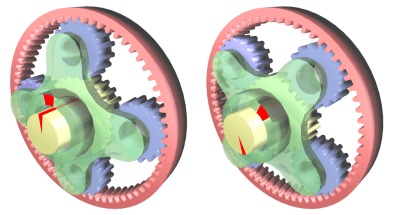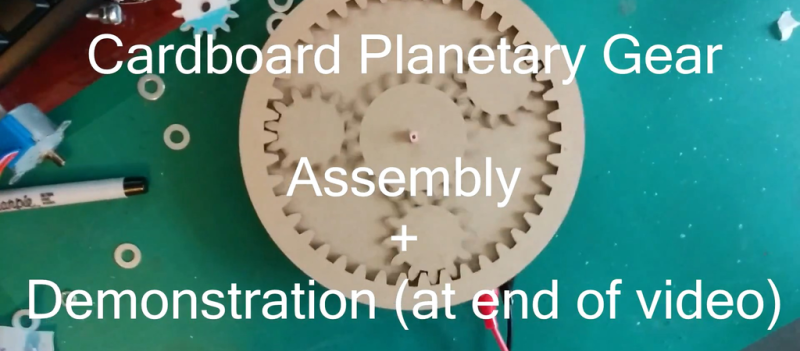[Shane] made a project that speaks directly to our heart — combining laser cutting, cardboard, and gears. How could it be any better? Well, it could do anything. But that’s quibbling. It’s fun enough just to watch the laser-cut cardboard planetary gears turn. (Video after the break.)
It was made on a laser cutter using the gear extensions for generating gears in Inkscape, everybody’s favorite free SVG editor.
In his writeup, [Shane] touches on all of the relevant details: all of the gear pitches need to be the same, and the number of teeth in the sun gear (in the center) needs to equal the number of teeth in the ring (outside) divided by the number of planets (orbiting, in the middle). So far so good.
We’re watching it go for a few minutes, and then thinking to ourselves, isn’t something else supposed to be turning? How does this thing transmit power?

We demand satisfaction! [Shane] you owe us a carrier race. We e-mailed [Shane] directly. He said that was his next step, but there’s nothing like a lighthearted public shaming for project motivation!
In the meantime, get your gear fix by ogling this planetary-gear based clock or this retrotechtacular Army film.
















It’s uselessness is useful because it demonstrates (physically) how a planetary transmission stage works.
For example most gearboxes used in wind turbines will use this setup as their primary stage where the high rotor torque and the low rotational speed is turned into lower rotor torque and higher rotational speed.
The mainshaft of these wind turbines drives the planet carrier(which indeed is missing) while the ring gear is fixed
driving the planets and these make the sun gear turning faster than the planet carrier.
(Ring gear how to spot it = it’s a part of the gearbox housing you can clearly see it from the outside in constrast to the other parts of the gbx housing made of cast iron, you can see it (1) behind the big bars that make the torque support arms)
(1) http://www.windsourcing.com/media/image/NEW-Moventas-PLH-400PW56-gearbox53db8ca62be26.jpg
Beeing pretty is a function too. The only thing that hurts my eyes a bit is that the planets arent spaced equally ;).
It can be a clock!!
Great video, but it blows the Wadsworth constant out of the water!
Made me cringe watching the gears that are not properly spaced.
Soak the gears in wood stabilizing resin, (google Cactus Juice stabilizing resin), apply vacuum, remove, bake, result -> hard resin gears in the colour of your choice. Polish gears to a mirror finish -> glass finish geared clock… Not so useless now are they?
Whenever I see gears I think of this video, I could watch things like this for hours. this is only a few minutes though.
[youtube=https://www.youtube.com/watch?v=mkQ2pXkYjRM]
Sure am grateful for the assembly video. Now that I think about it, using your hands to put it together makes perfect sense.
Some friends of mine run a company called Steamy Tech. They sell all sorts of laser-cut wood planetary gear based items on Etsy. I design circuit boards for some of their items.
Your equation for the number of gear teeth is wrong. The number of teeth in the outer ring is equal to the number of teeth in the sun gear plus twice the number of one of the planet gears.
A greeting card or novelty card with a working planetary gear set in it would be really interesting. You’d have to use some 10mil or thicker cardboard, but it could still be made to work.
Also, it would be really interesting if someone built a working model of the Prius power split transmission, which I believe is one or two planetary gear trains, using some small DC motors and h-bridges.